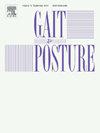Reinforcement and error feedback differentially impact motor exploration during locomotion
IF 2.2
3区 医学
Q3 NEUROSCIENCES
引用次数: 0
Abstract
Introduction
Reinforcement and error feedback are known to encourage motor exploration and learning. Studies of the upper limb have shown that reaches that are not rewarded lead to greater exploration, because the nervous system utilizes knowledge of movement variability to update aim towards a successful “reinforced” action. The current study investigated how reinforcement and error feedback influences motor exploration while walking and its impact on upright balance control.
Methods
Twenty-four healthy young subjects walked on an instrumented treadmill with a 180° virtual reality screen presenting feedback on their step length or step width. Subjects were instructed to match a target step length or width. Visual error feedback displayed their left foot step length or width as a black line within a target area. Reinforcement feedback displayed a gray target box that would turn blue when their left foot stepped within the box. We calculated lag-1 autocorrelations to assess exploratory behavior. Linear models of ankle roll and step placement were applied to assess whether the recruitment of balance mechanisms differed across feedback conditions.
Results
Both baseline walking and reinforcement feedback conditions led to greater motor exploration than error feedback for step length, but not for step width. Error feedback yielded corrective behavior, narrowing in on the target center regardless of target direction. Lag-1 values during reinforcement feedback were similar to baseline walking for both target directions. Analysis of the balance mechanisms showed that step width feedback changed balance strategy use. Center of mass was less predictive of ankle roll for the step width target conditions than at baseline.
Discussion
The regulation of step length follows similar trends to the regulation of upper body reaching behaviour under both error and reinforcement feedback. However, maintaining balance leads to reduced exploration for step width targets, and altered balance mechanism use in response to feedback.
在运动过程中,强化和误差反馈对运动探索有不同的影响
强化和错误反馈被认为可以促进运动探索和学习。对上肢的研究表明,没有奖励的动作会导致更大的探索,因为神经系统利用运动可变性的知识来更新目标,以成功地“强化”动作。本研究探讨了强化和误差反馈如何影响行走时的运动探索及其对直立平衡控制的影响。方法24名健康青年受试者在带仪器的跑步机上行走,该跑步机上有180°虚拟现实屏幕,显示他们的步长或步宽反馈。受试者被要求匹配目标步长或步宽。视觉误差反馈显示他们的左脚步长或宽度为目标区域内的黑线。强化反馈显示了一个灰色的目标框,当他们的左脚踩到盒子里时,这个目标框会变成蓝色。我们计算lag-1自相关性来评估探索行为。应用踝关节滚动和台阶放置的线性模型来评估不同反馈条件下平衡机制的招募是否存在差异。结果基线步行和强化反馈条件在步长上都比误差反馈导致更大的运动探索,但在步宽上没有。误差反馈产生了纠正行为,无论目标方向如何,都在目标中心缩小。强化反馈时Lag-1值与目标方向的基线行走值相似。对平衡机制的分析表明,步长反馈改变了平衡策略的使用。在步宽目标条件下,质心对踝关节滚动的预测比基线时要小。在误差反馈和强化反馈下,步长的调节与上肢到达行为的调节有相似的趋势。然而,维持平衡会减少对步宽目标的探索,并改变平衡机制对反馈的响应。
本文章由计算机程序翻译,如有差异,请以英文原文为准。
求助全文
约1分钟内获得全文
求助全文
来源期刊

Gait & posture
医学-神经科学
CiteScore
4.70
自引率
12.50%
发文量
616
审稿时长
6 months
期刊介绍:
Gait & Posture is a vehicle for the publication of up-to-date basic and clinical research on all aspects of locomotion and balance.
The topics covered include: Techniques for the measurement of gait and posture, and the standardization of results presentation; Studies of normal and pathological gait; Treatment of gait and postural abnormalities; Biomechanical and theoretical approaches to gait and posture; Mathematical models of joint and muscle mechanics; Neurological and musculoskeletal function in gait and posture; The evolution of upright posture and bipedal locomotion; Adaptations of carrying loads, walking on uneven surfaces, climbing stairs etc; spinal biomechanics only if they are directly related to gait and/or posture and are of general interest to our readers; The effect of aging and development on gait and posture; Psychological and cultural aspects of gait; Patient education.
 求助内容:
求助内容: 应助结果提醒方式:
应助结果提醒方式:


